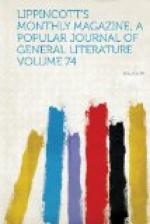The cavalcade comprised seven of the native carts, each drawn by two mules. Their construction may be thus described: A sort of barrow made of blue cloth hangs like a box upon an axletree about a yard long, furnished with two clumsy wheels. It is impossible to lie down in them, because they are too short, nor can a bench to sit on be placed in them, because they are too low. As a compensation, however, they are so light that they can go anywhere. The driver sits on the left shaft, where he is conveniently placed for leaping down to beat the mules. These are harnessed, one in the shafts and the other in front, with long traces tied upon the axletree near the left wheel. As they are guided only by the voice, the course of the cart depends chiefly upon the fancy they may take for following or neglecting the road; while from the manner in which they are harnessed their draught is always sideways, and they therefore trot obliquely.
At Yang-Soun the party was joined by a mandarin with a crystal button, sent by the governor of the province of Tien-Tsin, Tchoung-Hao, with a profusion of passports and safe-conducts. During the rest of the journey this mandarin, Ching, led the way in his cart drawn by a fine black mule, and on arriving at the villages on the route displayed his function, as a man of letters, by putting on an immense pair of spectacles, the glasses of which were about three inches in diameter. At Ho-Chi-Wou the procession halted during the middle of the day, and was photographed by one of its members. The curious crowd of spectators which gathered in every village to inspect the “foreign devils” scattered when the camera was posed, and for a few moments our travelers were freed from their intrusiveness.
[Illustration: Avenue of animals leading to the tombs of the emperors.]
Starting next morning at daylight, at three in the afternoon the party entered Pekin. The relief was great to leave the sandy, dusty road for one of the paved ways which radiate from the city. The first sight of the city struck the travelers as the most grandiose spectacle of the Celestial Empire. In front rose a high tower, with a five-storied roof of green tiles, pierced with five rows of large portholes, from which grinned the mouths of cannon; while to the right and left, as far as could be seen, stretched the gigantic wall surrounding the city, built partly of granite and partly of large gray bricks, with salients, battlements and loopholes, wearing a decidedly martial air. This impression was somewhat modified, however, by the discovery that the grinning cannons were made of wood. The entrance was under a vaulted archway, through which streamed a converging crowd of Chinese, Mongols, Tartars, with their various costumes, together with blue carts, files of mules and caravans of heavily-loaded camels.




